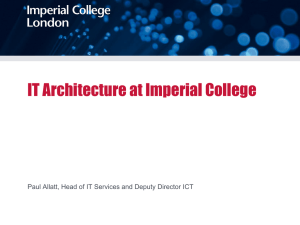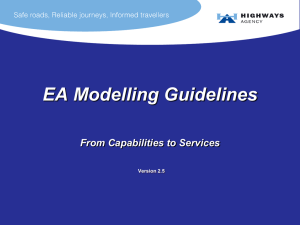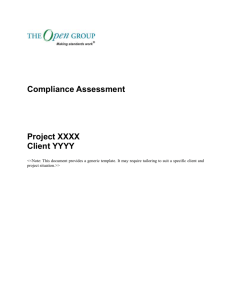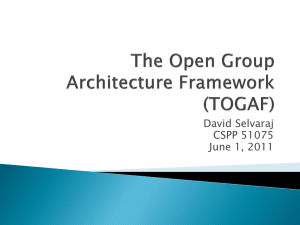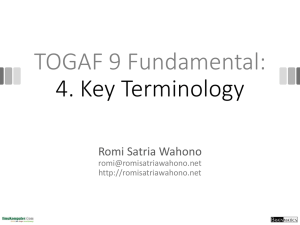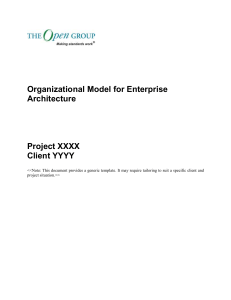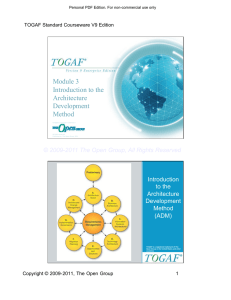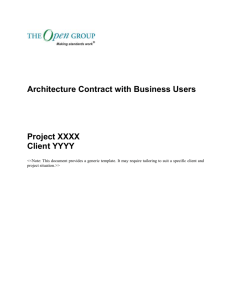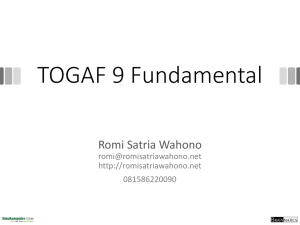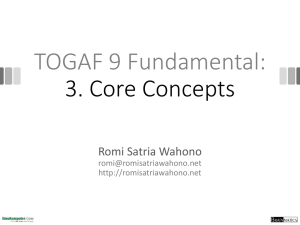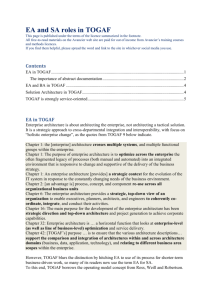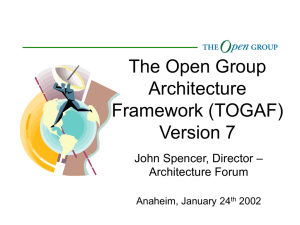e-services ToT module8
advertisement
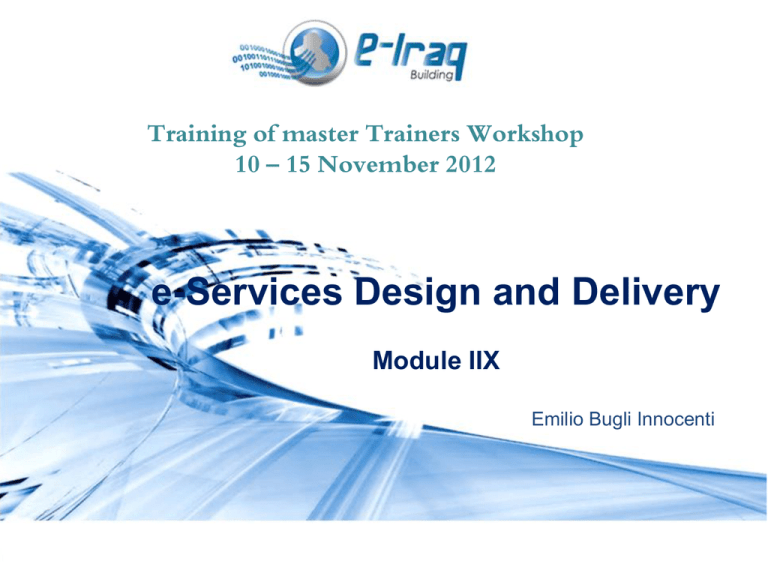
Training of master Trainers Workshop 10 – 15 November 2012 e-Services Design and Delivery Module IIX Emilio Bugli Innocenti e-Services Design & Delivery Contents of MODULE X – “e-Services Design & Delivery” Group Exercise: TOGAF Architecture e-Services Design & Delivery TOGAF Enterprise Architecture Framework • • • • • • • TOGAF is a framework for developing an enterprise architecture Published by The Open Group (Open Group 20012) The original development of TOGAF Version 1 in 1995 was based on the Technical Architecture Framework for Information Management (TAFIM), developed by the US Department of Defense (Open Group 2002) The Open Group is an international vendor and technology-neutral consortium TOGAF support different stakeholder views TOGAF includes all main architecture elements of EA TOGAF includes guidelines and tools how to build an enterprise architecture. In TOGAF this is called the Architecture Development Method (ADM) and it is an essential part of the framework e-Services Design & Delivery TOGAF Architecture Development Method – ADM e-Services Design & Delivery TOGAF Architecture Development Method – ADM • TOGAF’s Architecture Development Method (ADM) is a cyclic and iterative method to support the enterprise architecture building process • TOGAF Architecture Development Method (ADM) describes a step-by-step approach to develop an enterprise architecture • ADM is a generic model and each organization should decide if they want to customize it for specific needs or exploit the generic model • Developing an enterprise architecture with the ADM is an iterative process, which consist of eight stages e-Services Design & Delivery ADM PHASES 1. Architecture Vision • In the first phase the strategic business requirements are defined and relevant stakeholders identified. Also an architecture vision to meet these requirements is determined 2. Business Architecture • In the second phase the current baseline business architecture is described and target business architecture developed • This phase is used to analyze the gaps between the baseline and the target business architectures. 3. Information systems architecture • The objective of the third phase is to develop target architectures – Information architecture • Define the major types and sources of data necessary to support the business, but this does not mean atabase design or the design of any logical or physical storage systems – Applications architecture • Define what major applications are required to process the data and support the business e-Services Design & Delivery ADM PHASES 4. Technical architecture • This phase consists of eight sub-phases: create baseline, consider different views, create architectural model, select ervices portfolio, confirm business objectives are met by architecture model, determine criteria for specifications, define architecture completely and conduct gap-analysis 5. Opportunities and solutions • identifies the strategic change and the top- level projects to be undertaken in moving from the current environment to the target architecture 6. Migration planning • developing the various project plans for projects, which have to be implemented. This phase is also for prioritizing these plans. 7. Implementation governance • to formulate recommendations and plans for each implementation project and then implement and deploy the systems 8. Architecture Change Management • includes creating a maintenance procedure for the new baseline that has been implemented in the previous phase e- Service Design & Delivery TOGAF Exercise Describe and analyse enterprise architecture using TOGAF, or selected part of enterprise architecture, in your administrationcompany (or other organization) Analyse whole enterprise architecture, or selected part (listed • below) of enterprise architecture: • – Business architecture • – Information architecture • – Systems/Applications architecture • – Technical architecture You can also choose to analyse only few phases of architecture development instead of the whole development cycle e- Service Design & Delivery TOGAF Exercise Split into Groups and decide the target administration You can choose to analyse the entire Architecture or to have a specific focus on some views (Business, Data, etc.) Describe the selected architecture elements and how those are integrated • • • • Business architecture Information architecture Systems/Applications architecture ERP, CRM, payroll, warehouse management, reporting etc. Technical architecture e- Service Design & Delivery TOGAF Exercise – Potential Topics to Discuss Initial architecture • Are there any particularly effective applications in your initial business application architecture? • Have you recognised unused potential in applications in your initial business application architecture? • Have you evaluated risks concerning business application architecture (e.g. vendor risks, technology risks) • Level of integration (interfaces between applications, what data is integrated) • Key drivers in making changes in business application architecture • Old legacy systems => forced to replace • Changes in business environment • Changes in company structure • Exploit possibilities for new business opportunities (e.g. additional sales through internet) e- Service Design & Delivery TOGAF Exercise – Potential Topics to Discuss Architecture Development • • • • • • • • • • Has there been any particular method in developing target business application architecture? How business requirements and business application architecture is aligned? What were the critical business requirements or critical success factors that affected on the business application architecture development? What were common requirements and business unit level requirements? Different stakeholders involved in business application architecture development (for instance business management, IT management, users)? Influence of external parties (partners, customers, suppliers, competitors) and environment to business application architecture? How application architecture has been developed in time (order of implementation)? Priority of different applications? Is this implementation order based on enterprise architecture planning point of view or more because of external reasons or reasons like acquisitions, changes in company structure etc.? What practical constraints have been considered in business application architecture development? e- Service Design & Delivery TOGAF Exercise – Potential Topics to Discuss Target Application Architecture • How far are you from your target architecture? • Was target architecture clear from the beginning or has it evolved over time? • Level of integration (interfaces between applications, what data is integrated) • Centralized elements of architecture vs. local elements? Information Architecture • Do you have information architecture (or list of information requirements)=> e.g. have you mapped what data exist in which systems (e.g. product, customer and/or supplier data)? • Have you created information architecture before application architecture? • Is your information architecture independent from application architecture? • How much you have information entities overlapping in various applications? • Quality of information (how accurate the data content is)? e- Service Design & Delivery TOGAF Exercise – Potential Topics to Discuss Target Application Architecture • How far are you from your target architecture? • Was target architecture clear from the beginning or has it evolved over time? • Level of integration (interfaces between applications, what data is integrated) • Centralized elements of architecture vs. local elements? Information Architecture • Do you have information architecture (or list of information requirements)=> e.g. have you mapped what data exist in which systems (e.g. product, customer and/or supplier data)? • Have you created information architecture before application architecture? • Is your information architecture independent from application architecture? • How much you have information entities overlapping in various applications? • Quality of information (how accurate the data content is)?
